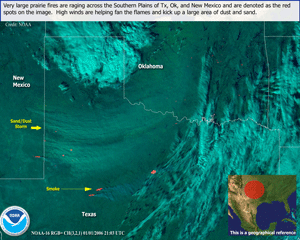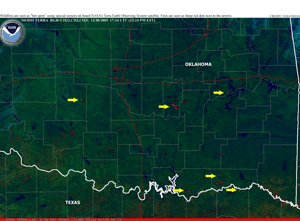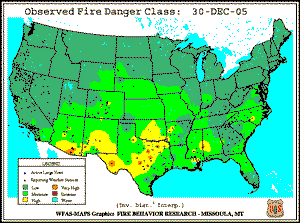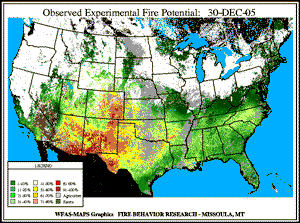Use the form below to select from a collection of monthly summaries recapping climate-related occurrences on both a global and national scale.
Wildfires ReportAnnual 2005
Wildfire activity erupted across parts of the central U.S. during December 2005, as numerous large fires developed especially in Oklahoma, Texas and the southern Plains. Many of these fires continued to burn into early January 2006. As of January 9th over 400,000 acres had burned across the southern Plains since the New Year, normally a time of very low fire activity.
Preliminary estimates from the National Interagency Fire Center suggest that 2005 will break the record set in 2000 for acreage burned, with over 8.53 million acres burned across the U.S. by the end of December. During the 2000 fire season over 8.43 million acres were consumed across the entire U.S., with over 7 million acres burned in the contiguous U.S.
Alaska had its second consecutive year with widespread wildfire activity, as over 4.4 million acres burned in 2005 across the state.
The total number of fires across the U.S. continued to decline in 2005. This fact, combined with the increase in acreage, suggests that the average size of individual fires has increased over the past 20 years.
| Totals from December 31st | Nationwide Number of Fires | Nationwide Number of Acres Burned |
|---|---|---|
| 2005 | 64,303 | 8,538,042 |
| 2004 | 77,534 | 6,790,692 |
| 2003 | 63,269 | 3,959,223 |
| 5–year Average | 69,082 | 4,311,346 |
Dead fuel moisture levels across the southern and central Plains states decreased during December. In particular, fine fuel moisture levels (i.e., 10–hour fuels) decreased below 5% across parts of Texas, Oklahoma, Arizona, New Mexico and the Front Range of Colorado during the past month.
Medium to larger fuels (i.e., the 30 December 100–hr and 30 December 1000–hr fuel moistures) were also unusually dry for the winter, especially across the Southwest and southern Plains areas.
The Keetch–Byram Drought Index (KBDI), a widely used index for fire risk, had the largest potential for wildland fire activity in the contiguous U.S. across parts of the central and southern Plains at the end of December.
For further information on drought conditions across the U.S. go to the December drought summary page.
 NOAA's National Centers for Environmental Information
NOAA's National Centers for Environmental Information





